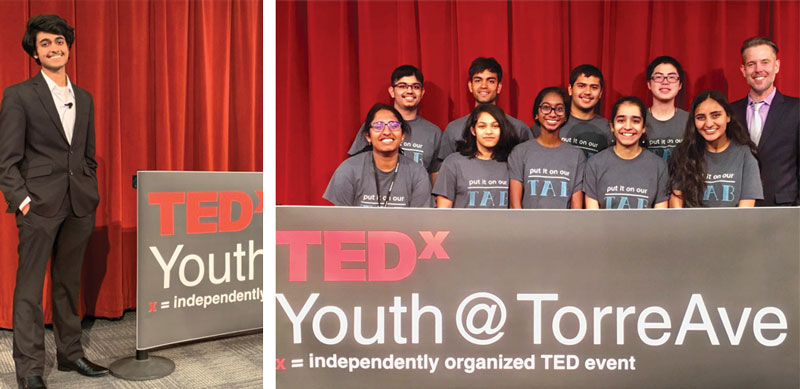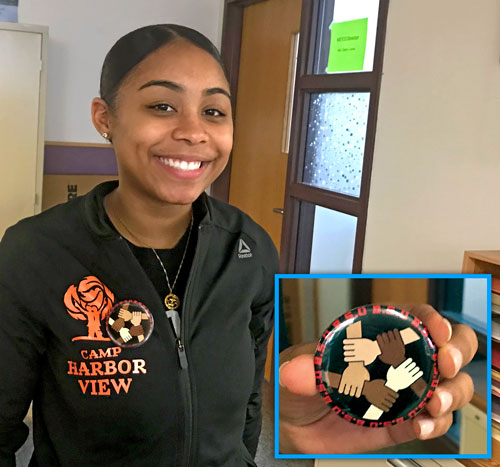Let Teens Take Charge of STEM Learning
Whether conducting TEDx talks or using makerspaces to explore their passions, teens with the freedom to drive activities stay the most engaged.
 |
The Teen Advisory Board from last year’s Teen TEDx event at the Cupertino (CA) Public Library.From the left: Photo courtesy of Sripad Sureshbabu; Photo courtesy of Matt Lorenzo, Cupertino Library. |
Sripad Sureshbabu (above left) nearly had the scoop of the century. Last year, the then 16-year-old junior from Cupertino (CA) High School turned his fascination with biology into award-winning work.
His project garnered first place in biological science at the Synopsys Science Fair; he was a semifinalist at the USA Biolympiad. Now here he was, onstage, closing the first Teen TEDx event at his high school. Sureshbabu was talking passionately about how germs can evolve faster than the medicines we create and how we needed nanotechnology and artificial intelligence (AI) to keep pace.
Sureshbabu was not specifically describing the potential of viruses to wreak havoc on the world. He was focusing instead on antibiotic-resistant bacteria. In a white dress shirt and dark suit, he stalked the stage, imploring his audience to pay more attention to “superbugs,” those strains of bacteria that are resistant to all antibiotics. He discussed how we could fight this trend by harnessing AI and phage therapy, the ability to create a “good” virus that invades bacterial cells to stop the “bad” bacteria.
In addition to pursuing his own STEM research, Sureshbabu is one of many teens taking an active part in creating STEM programming around these topics at school and public libraries. As STEM education nears its 20th anniversary—the acronym was introduced in 2001 by administrators at the U.S. National Science Foundation—the push to include technology and engineering with the staples of math and science has permeated nearly every school and library. Maker labs, many stuffed with technology including 3-D printers and laser cutters, along with more traditional tech like sewing machines, invite teenagers to innovate and learn cutting-edge skills.
In many of these environments, educators are turning the keys over to the kids, in keeping with the understanding that teen-led activities often have the most staying power. Top-down instruction often doesn’t engage teens, because it can put an artificial limit on what they might make, discover, or learn. Libraries from Sureshbabu’s tech-saturated Cupertino Library to Libertyville, IL, are programming in a way that allows teens to create and promote STEM programs to stir interest and boost learning.

Open-ended exercises
“We have our best luck when [students] already know about a topic and they can tell us about it,” says Heather Love Beverley, assistant manager of youth services at the Cook Memorial Public Library District in Libertyville. The library where Beverley works is located near a school, and she says that in pre–COVID-19 times, it was filled with up to 120 teens after school, making it easy to talk with students and find out what programs they might prefer.
The district includes two libraries and typically runs two STEM activities per summer, she adds. Her best programs offer students competition (“even without a prize,” she adds) and allow the teens to use directions simply as a “jumping-off point.” In the past, students have worked on creating the fastest zip lines and building a switch-operated catapult.
The same dynamics are at play in Cupertino, where a teen advisory board informs much of what teen services librarian Matt Lorenzo programs throughout the year.
“The teens here are very tech-savvy,” he says, so the library—located in the middle of Silicon Valley—naturally has a big STEM focus. Teens helped initiate the library’s first overnight hackathon three years ago, begin the Teen TEDx series that kicked off with Sureshbabu last year, and create an online app design contest.
“They take a lot of pride and ownership in programs they have developed,” Lorenzo says. The bustling library typically holds four to five events for teens every month.
In nearby San Jose, senior librarian Lizzie Nolan says the Martin Luther King Library certainly serves a swath of tech-savvy teens while also striving to create programming for teens who might feel intimidated by some of the cutting-edge tools.
One way Nolan makes sure to hold teens’ interest is to keep up on what schools in the area are teaching and offering for clubs. For instance, robotics is “well-covered ground” in San Jose, she says, so to reach teens who have grown up with a tech background, the library emphasizes computer technology or how to use science to combat global warming.
“Tech is what fuels this city, but there’s a whole other side to San Jose,” she says, where low-income families live in close proximity to extreme wealth. She found that creating general-interest programs and “sneaking” in equipment such as a 3-D printer drew students more broadly than a hyped-up tech program that might scare them off before they start.
 |
Lereca Rodrigues, co-president of the Black Student Union at Sharon (MA) High School, wears a button the group produced in the library makerspace.Photos courtesy of Cathy Collins, Sharon Public Schools |
Teen attractions
Nolan and other librarians say that one fail-safe rule to follow is to run STEM programs that allow teens not only to create something, but also to have something to take home when finished. Nolan finds the laser cutter at her library to be more popular than the 3-D printer, because it is easier to set up and students can create a detailed design quickly. Students have created keychains as well as items from wood and cardboard, she says.
Library media specialist Emily Bredberg has run STEM programs in an elementary school and her current position at Shrewsbury (MA) High School. While she finds the youngest learners more willing to experiment, she has found that teens need a more controlled environment that points them in a particular direction.
“High school students are really great at challenges and when the [project] is part of their curriculum,” Bredberg says. While she doesn’t have a formal teen advisory board, the student-run iPad repair center based in her library gives her easy access to technology-loving students.
Cathy Cormier, the program manager at The Mix, San Francisco Public Library’s (SFPL) teen center, got a $100,000 federal grant to create a teen center in 2015. She allowed teens to help design the space, where the recording studio is a popular draw. It’s not complicated, Nolan says. “Every middle or high school student wants to be a YouTube star.” The Mix also has an extensive maker studio, multiple gaming opportunities, and a video studio, as well as a laptop lending kiosk, desktops, a record player, and a typewriter.
No matter the bells and whistles, it can be hard to get some high schoolers to commit to a program because their time can be gobbled up by schoolwork, sports, and college applications, Bredberg notes.
That was the case at nearby Sharon (MA) High School, compounded by the fact that the maker space is located in the back of the library, so some students just don’t see what’s available. To start, school librarian Cathy Collins moved some of her simpler tools, such as Sphero balls, to a table in the hallway, where students spend much more time experimenting with them.
Taking a more direct approach, Collins sought to integrate her work with existing curricula. A recent win occurred when an AP psychology teacher brought her abstract thinkers into the library, challenging students to make a model of a neuron.
“These are students who had little interest in STEM,” Collins says. They had fun creating their models and now know what tools the library has, so they’re more likely to return later.
The future was on every librarian’s mind as most programming ground to a halt on account of COVID-19. With so much uncertainty about when libraries will reopen, these experts shared their best guesses for what types of programming might lure teens back when in-person activities restart.
“Rather than programming, I’m going to put out things so [teens] can engage with their friends,” says Bredberg. When it is safe to gather, she thinks board games and simple tools such as LEGO will be hits.
Beverley knows that with summer programming canceled, she’s losing the most popular time of year to attract teens. “It’s going to be a slow return to programming,” she says, adding that she’ll probably concentrate on Friday afternoon offerings, because that can be one block teens are free.
Despite coronavirus worries, Lorenzo says that his teen advisers were so excited about last year’s Cupertino Teen TEDx they are already planning a new one for this year. “We’ll do it virtually, using Zoom,” he says. While it won’t be the same as speaking to a room full of 100 people, Lorenzo says that 30 students have already auditioned to be one of the program’s six speakers.
The virus is making us “rethink our safety,” Lorenzo says. But when his library reopens, he predicts teens will soon follow. “They’ll be excited to get back and use our resources and hang out.”
Wayne D’Orio is a veteran editor and reporter and a regular contributor to the Hechinger Report.
RELATED
The job outlook in 2030: Librarians will be in demand
The job outlook in 2030: Librarians will be in demand
ALREADY A SUBSCRIBER? LOG IN
We are currently offering this content for free. Sign up now to activate your personal profile, where you can save articles for future viewing






Add Comment :-
Be the first reader to comment.
Comment Policy:
Comment should not be empty !!!